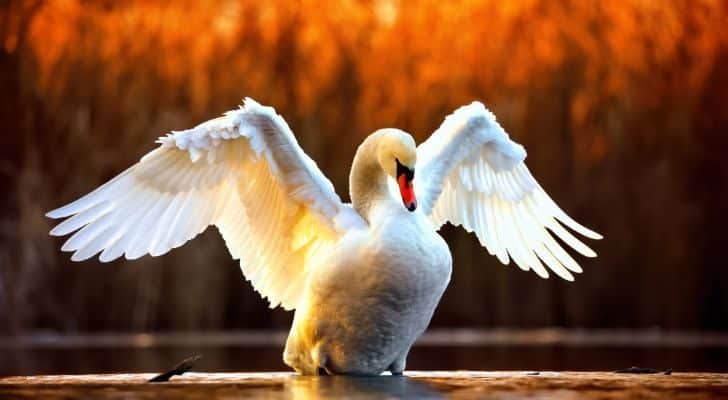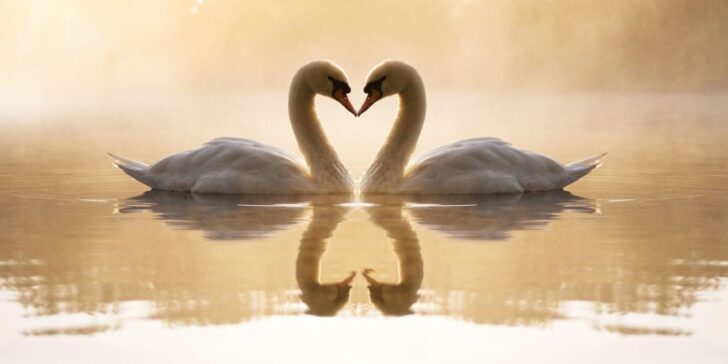With their pristine white feathers and long, elegantly curved necks, swans are undoubtedly one of the most graceful creatures on earth.
While they’re certainly beautiful to look at from afar, don’t go putting yourself in danger by trying to get a close look at them, as they can be quite ferocious!
If you want to know more about swans, you don’t have to meet them up close – you can just read all about them here instead! Stick around for a while as we share 30 fun swan facts that you didn’t know!
Swans are some of the largest flying birds, with the biggest swan species growing up to 59 inches (1.5 meters) long and weighing as much as 33 pounds (15 kilograms)!
There are six living species of swan: whooper swans, trumpeter swans, mute swans, black swans, black-necked swans, and tundra swans.
Swans belong to the biological family Anatidae, which also contains ducks and geese.
Baby swans are called swanlings or cygnets, male swans are called cobs, and females are called pens.
Swans typically pair up with a partner for life, or at least until the end of one of the pair’s life!
That said, swans will sometimes go through a ‘divorce’ of sorts, which is most common if they fail to have any cygnets or their nest gets destroyed.
In fact, swans are considered to be a sign of love and commitment because of their life-long pairing.
Swans can be aggressively territorial and will fight anyone and anything which comes near their nest during mating season. If you hear a swan hissing at you, run!
Depending on the species, swans can live as long as twenty-four years.
Groups of swans can have different names. When swans are in flight, they’re called a wedge, when they’re in the water, they are often called a bevvy. And when they gather on the water’s edge, they’re called a bank!
It’s OK to feed bread to swans, as long as the bread isn’t moldy and you don’t get too close!
Swans lay an average of five eggs per clutch and sit on them for as long as forty-five days before they hatch.
Male swans stay on guard duty the whole time a female swan sits on her eggs, and even perform victory dances after warding off predators.
Guard duty doesn’t end for male swans once cygnets are born, though, as it’s their duty to protect them while out on the water. This is why they often try to chase and attack boats!
Only three companies in the UK are allowed to legally own swans: The Abbotsbury Swannery, The Vintners Company, and The Dyers’ Company.
Britain’s monarch has the right to claim any mute swan found in Britain, provided it’s not already owned by one of the three companies previously listed.
Not only that, but it was high treason to kill swans in Britain. This outlandish law was only changed in 1998.
Black swans are not natively found in Europe and were actually brought from Australia in the 1800s.
Despite this, Europeans have been talking about black swans since at least the 1st century AD, with a black swan being a figure of speech for something impossible!
The Aboriginal Noongar people of Western Australia believed that black swans were once white but had their white feathers torn out by eagles for being too proud.
Meanwhile, Norwegian mythology states that swans are all white because their ancestors drank from a sacred well in Asgard that was so pure it turns all who drink from it white.
Swans mostly dine on roots, tubers, leaves, and stems of plants they pull up from under the water’s surface.
Speaking of dining, swans used to be eaten in England during the reign of Elizabeth the First, with recipes of baked swans mentioned in cookbooks.
Swans are quite sociable for most of the year, although they do tend to stay clear of any swan other than their partner during mating and breeding season.
Trumpeter swans are the largest and heaviest bird native to North America.
Due to their size, trumpeter swans were hunted close to extinction by the 1900s. Rigorous conservation efforts have brought their population levels back to acceptable levels.
According to Greek Mythology, Helen of Troy was the lovechild of Leda, Queen of Sparta, and Zeus disguised as a swan.
The Greek and Roman god Apollo was often depicted in a chariot pulled by swans.
Legends are told around the world of swan-maidens, who could shapeshift between swan and human forms.
The technical term for the irrational fear of swans is kiknophobia or cygnophobia.

It’s no small wonder that we’ve been pretty obsessed with swans over the centuries.
Sure, they’re feisty, but they’re so elegant and beautiful that it’s easy to forget!
We hope you’ve come to appreciate swans for what they really are, or enough at least to admire them from a distance!










